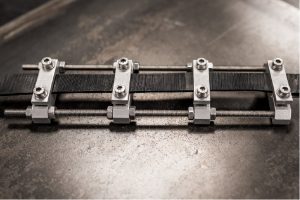Ozone & UV test methods
OZONE & ULTRAVIOLET RESISTANCE QUALITY STANDARDS
There are currently no internationally accepted quality standards applicable to ozone and ultra violet light resistance. However, considerable experience has been accumulated over recent years. These experiences have conclusively determined that in order to be adequately resistant to the damaging effects of ozone and UV, the rubber sample should not show any signs of cracking within a 96 hour period of concentrated exposure (@ 40°C, 50 pphm and 20% strain) inside an ozone test cabinet.
EN/ISO 1431 test methods
The internationally accepted test methods used to scientifically measure resistance to ozone are EN/ISO 1431. This test involves placing rubber belt samples under tension (eg. 20% elongation) inside an ozone testing cabinet and exposing the samples to highly concentrated levels of ozone for a period of time (eg.up to 96 hours).

Ground-level ozone seriously damages the rubber
Samples are closely examined for evidence of cracking at two-hourly intervals and the results carefully measured and recorded.

Ozone testing at Dunlop laboratory
